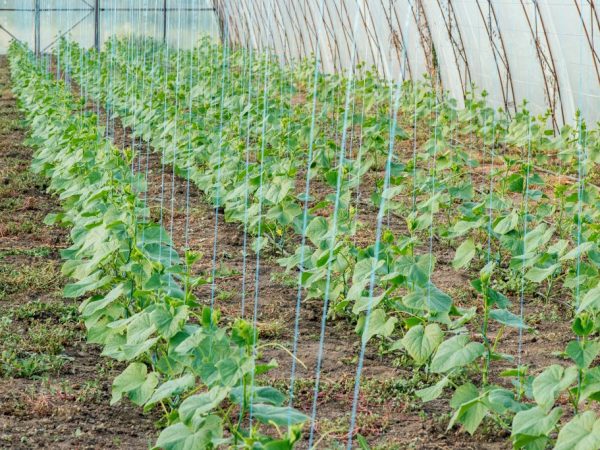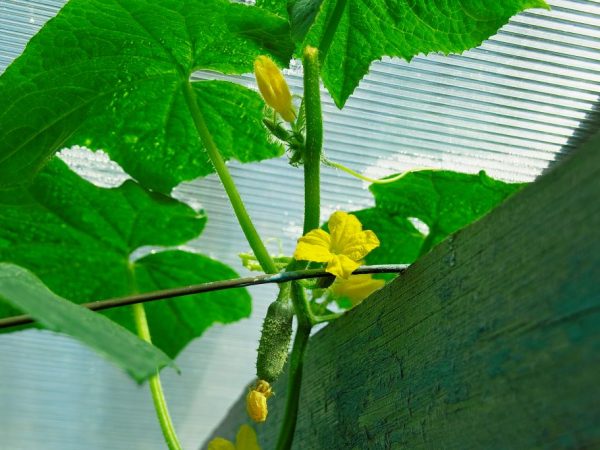Garter cucumbers in the greenhouse
The garter of cucumbers in a polycarbonate greenhouse contributes to the yield of the plant. Treatment procedures include frequent watering and feeding, which are carried out when the vegetable is attached to the greenhouse.

Garter cucumbers in the greenhouse
Features of tying cucumbers in a greenhouse
The tying procedure is carried out to protect the cucumber ovary. If it touches the ground, it will quickly rot. The action is performed after 4 weeks of growth of the bush, when its height is from 30 to 40 cm, 6 full leaves should be formed on it. The younger the bush, the more elastic its stem, in older cucumbers the stem breaks during the garter.
After the garter, the bush enters the set mesh with a mustache and does not fall down, allowing the fruit to be picked from all sides.
Tying cucumbers in a polycarbonate greenhouse not only simplifies their collection, but also helps to take care of them more comprehensively. Tying results in:
- providing the bush with better lighting;
- preservation of a large number of flowers;
- obstacle to the formation of ovaries with other bushes;
- possibility of easy access for fruit collection.
A properly tied bush is more illuminated by the sun's rays. The light hits the bush, which allows it to develop better and faster.
For each type of cucumber, tying is selected individually. The base for the frame is assembled from sticks and metal fragments; plastic parts are rarely used.
Basic garter methods
Before tying cucumbers in a polycarbonate greenhouse, choose a garter method. Today there are such methods of tying in polycarbonate greenhouses:
- vertical;
- horizontal;
- blindness;
- creating a bush in several shoots;
- tying to a special net;
- mixed.
Let's take a closer look at how to tie cucumbers in a polycarbonate greenhouse.
Vertical way
When using vertical tying in high polycarbonate greenhouses, a support up to 2 m high is made under the ceiling. The plank is placed horizontally from the support. It is permissible to use wire instead. It is the place where the rope or twine is attached. The stems are tied to it.
Each bush has its own fulcrum, which greatly facilitates the care of the bush. In addition, cucumbers receive much more sunlight. Gardeners pull the rope onto the frame or attach hooks to the frame, and bury its other end in the ground.

The whips are tied to a stretched wire
The vertical method is performed using a frame, where the upper bar is located under the very ceiling of the greenhouse, and the lower one almost lies on the ground. A wire or rope is pulled between them.
When the bush reaches the top of the support, it is pruned to complete the growth. So cucumbers do not stop braiding the greenhouse and creating shade.
Horizontal way
With the horizontal method, tying in polycarbonate greenhouses is carried out by placing several metal supports at different ends. Their size depends on the greenhouse, but about 1 m in height is considered desirable. It is with them that stretched horizontal rows of strong and thick rope are tied.
The first horizontal step is placed at a distance of 30 cm. Others are attached at a distance of 35 cm. The stems cling to the horizontal bandage, and the cucumber continues its development along it.
The disadvantage of this method is that the bushes, after they grow to the first row, stop on it, do not try to crawl up.
"Blinding" cucumbers
The so-called "blinding" of cucumbers is often used by gardeners under greenhouse conditions for growing crops. The main stem of the cucumber is tied to a trellis, then all antennae and lateral shoots are removed from it at a distance of 50 cm from the beginning of growth.
Creation of a bush in several shoots
The method of creating a bush with cucumbers in several shoots is one of the newest. The plant is created from the main stem and a couple of side shoots. As in the previous method, the main shoot is fixed on the trellis. The lateral whiskers are left until the ovary is formed. Only after the appearance of small cucumbers, the shoots are attached to the trunk.
During the formation of the fruits, several garters with a mustache are carried out, while all excess mustaches and shoots are cut off, otherwise the quantity and quality of the crop decreases.
In order not to injure the bush when tying, the angle between the main and lateral shoots should be at least 60 °.
Mixed garter method
This type is used when planting cucumbers in a circle. From 7 to 11 metal rods in the form of a cone are inserted into the ground, a mesh is put on them, antennae are inserted into its holes. Tying up bushes in this way is easy. The plant itself will braid the shape, forming a hut.
The support is prepared before sowing seeds in the greenhouse, because when it is arranged near young plants, there is a possibility of mechanically damaging the stem or leaves.
Tying to a special net
You can tie up homemade cucumbers in a polycarbonate greenhouse using a net. There are high quality threads that can support weight and do not deteriorate from weather conditions, they are used for mesh. A frame is installed in the greenhouse and the mesh is pulled.
This method facilitates the work of gardeners, because you do not need to tie each bush, and the plant itself grows upward with the help of antennae.
How to carry out a garter

Garter materials must not harm the plant
The garter material also plays an important role in the formation of the bush. Incorrectly selected retainers injure the plant stem.
Old textile scraps
Ribbons from 1.5 to 3.5 cm wide are cut from unnecessary rags and scraps. They are tied or stitched together, as a result, a trellis of a suitable length is obtained.
The main disadvantage of the method is the low strength and rapid wear of the rag trellis.
Thin long branches
Thin sticks are used to form the site. The branches are freed from all lateral shoots.
The bushes are fixed to the frame with a wire, from below they are inserted into the ground. Cucumbers love to wrap around a support and are normally held at the same time.
Twine garter
Twine is used to create a vertical area. Natural jute is considered the best.
You should not take twine from nylon or nylon: these materials injure bushes, in addition, cucumber whips fall down under the weight of the plant.
The twine is attached at the top of the greenhouse profile, then it is lowered to the ground. The twine is tied on the side shoots of a cucumber, retreating 40 cm from the trellis.
Greenhouse requirements
Polycarbonate greenhouses are increasingly being installed to be able to grow plants in winter.
When installing a greenhouse, a number of requirements are met. The structure is placed in an open area so that no shadow falls on it. They also make a foundation by pouring 40 cm of concrete.The best location is west to east. Such winter greenhouses help to realize all the possibilities of early and late varieties of cucumbers.
Conclusion
When tying cucumbers in a polycarbonate greenhouse, the gardener receives many advantages: convenience when working with the crop from planting to harvest, preventing adhesion of plants that grow nearby, reducing infections, preventing the appearance of shade. Subsequently, there is a decrease in the number of spoiled fruits and lateral shoots are formed, giving more yield than the central ones.


